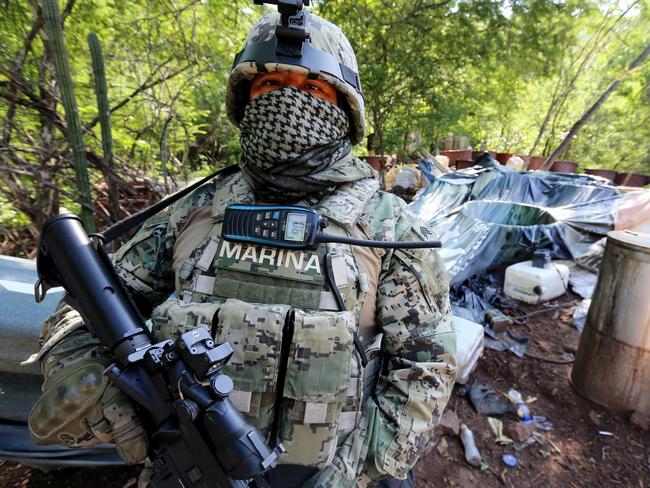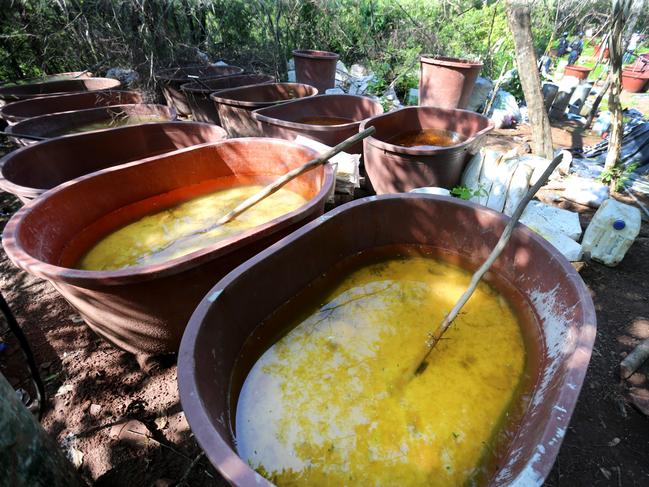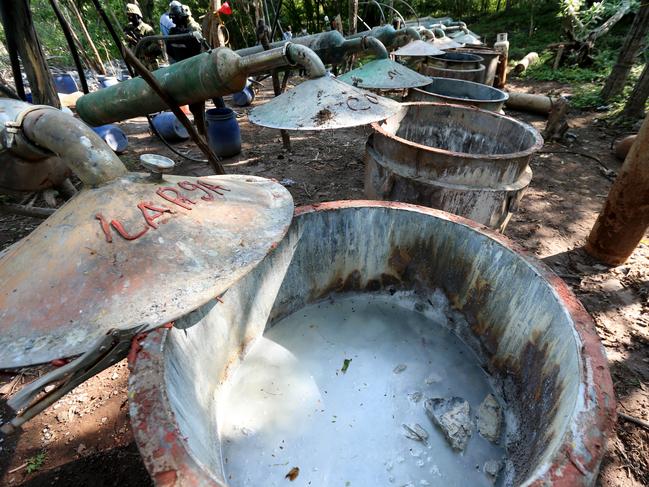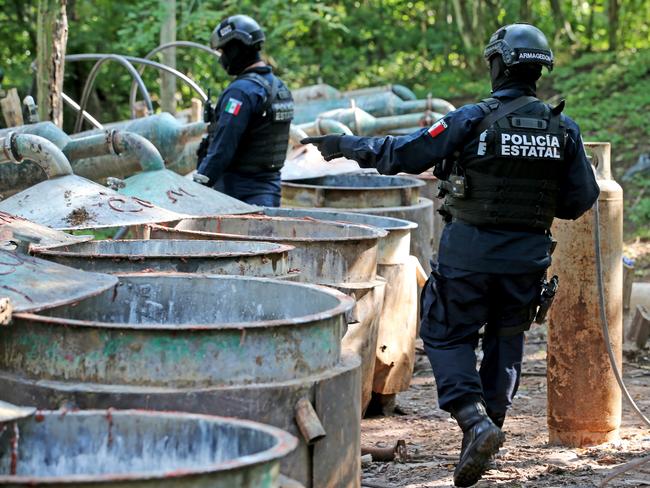Inside the Mexican Sinaloa drug cartel labs bringing meth to Australia
These are the jungle labs of the fearsome Mexican Sinaloa drug cartel that are producing the next generation of methamphetamine flooding our streets across Australia. SEE THE VIDEO
True Crime
Don't miss out on the headlines from True Crime. Followed categories will be added to My News.
Exclusive: Churning out tonnes each day of a new strain of more pure and deadly ice which is increasingly targeting Australians, these are the jungle labs of Mexico’s fearsome drug cartels.
Australian police have warned of a new generation of methamphetamine flooding the local market as News Corp Australia travelled into the heartland of the Sinaloa cartel.


Labelled “meth 2.0” by US authorities, the Sinaloa ice is made by swapping hard-to-get pseudoephedrine for cheap and readily available Chinese-made chemical precursors.
The sky-high profits are driving a new wave of cartel violence in the region, including last week’s murders of nine US citizens – six children and their mothers – as well as an armed takeover of Culiacan last month that forced the release of gang boss Ovidio Guzman, the son of jailed kingpin El Chapo.


“We have a problem with methamphetamine coming out of Mexico,” says Australian Federal Police Detective Superintendent Conrad Jensen, senior officer for Latin America for the Australian Federal Police, who is based in Mexico City.
“It’s certainly on a super-size scale.”
News Corp Australia was the first Australian media to visit the meth factories on a four-day embed with the Sinaloa State Police last month which unveiled two recently seized labs producing 30 tonnes a month of ice between them.

SSP deputy chief, Major Carlos Leyva said the cartel’s ice production was booming and had replaced marijuana and Colombian cocaine as its main drug output. His elite team has raided at least 49 labs this year, compared to just nine in 2018 and he says he doesn’t have enough officers to shut down new factories as they learn of them.

“It is a booming business and their output is getting bigger all the time,” Major Leyva said.
Major Leyva also admitted that despite the raids, his officers had not made a single arrest at the jungle labs in two years, with the Sinaloa cartel’s stranglehold on the city so firm that its armies of informants had warned criminal gang members working there before he or his Marine and Army counterparts could take them down.

Major Leyva insisted the raids were worthwhile and impacting the cartel, given they disposed of all the drugs they found and disrupted their business.
Supt Jensen said the Mexican ice was considered premium quality by users, and was produced using a new method, dubbed P2P.
“The pre-precursor chemicals used to produce P2P in Mexico are being brought in from Asia and other places,” he said.

“Gone are the days of a backyard set up somewhere, and it’s now a lab-standard production.
“P2P is about going to the next level in terms of the amphetamine chemistry …
”That’s what they’re getting and they’re known for that internationally.
“The methamphetamine being produced in Mexico is generally of a higher quality.
“You can’t compare this to anything we’ve seen in Australia.”

US authorities are so concerned by the new generation of meth they recently warned it was on track to kill more Americans than the opioid crisis, with a recent spike in Mexican-produced ice deaths outpacing the early years of the opioid epidemic.
Booming demand has driven Australian drug users to pay among the world’s highest prices for ice, with a street value of $750 a gram compared to an average $53 a gram in the US, drawing growing focus from the cartels.

“The reason the Australian price is so high … is due to demand in Australia and supply factors, the price our drug users are willing to pay, distance and it is harder to get the drugs through our borders,” said Spt Jensen, who has been posted in Latin America for the past two years and works closely with US and Mexican authorities.
“We are a lucrative market and we’re certainly on the radar of the organised crime groups, the cartels here in Mexico.
“Like any sort of business enterprise they’re looking for new markets.
MORE:
Mexico’s top cocaine cartel infiltrates Australia
The hi-tech lab tracking Australia’s cocaine
Two deadly gangs join forces for $85m ice deal
El Chapo’s Mexican cartel flooding the streets with ice
The Sinaloa ice moves from shipping ports on the west coast of Mexico and the US, through Asia and is then handed off to their local contacts, usually bikies and Asian crime gangs but increasingly Mexican nationals.
Although Sinaloa cartel kingpin Joaquin “El Chapo” Guzman is jailed in the US, just how dangerous the criminal network he founded remains was made clear earlier this month, when nine Mexican army members were traded for the freedom of Ovidio Guzman, his son, after he was briefly arrested in Culiacan.
Thirteen people died in ten hours of gunfights through the state capital and the rolling over of the Mexican president to release Guzman has been described by security experts as “a new blueprint for organised crime groups”.
Just yesterday, one of Major Leyva’s officers, known as Condor, was murdered by cartel hitmen, or “sicarios”, as he made his way home from work.
The Mexican labs are producing about a third of Australia’s ice, according to the AFP, which worked with US authorities to seize an Australia-bound world record 1.7 tonnes ($1.3bn worth) in Los Angeles in January.

In August, another 755kg of ice was seized in Melbourne, packed in frozen cow hides, and a Mexican national has been charged.
“The number of seizures don’t reflect the true scale of the story, rather the size of the individual seizures,” Supt Jensen said.
“Where we used to see seizures of 50 to 100kg just a few years back, now they are well into the hundreds of kilos or even tonnes.”
